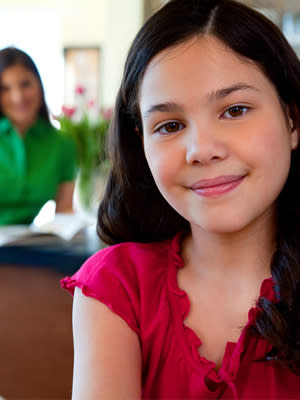Young Girls Want to Know: 5 Breast Questions Answered

As every parent knows, puberty is all about hormones. Somewhere between the ages of 8 and 12 for most girls, the brain sends a message to the ovaries, saying, "Hey, time to wake up and act pubertal!" The ovaries start producing estrogen, and reproductive organs, including breasts, begin to develop. The biologic purpose of breasts is to carry milk from moms to newborns, but breasts also contribute to a girl's feelings of femininity and attractiveness. (By the way, in studies of male views of female beauty, breast size ranks surprisingly far down the list of important physical attributes.)
If you have a daughter, here are the five most common questions girls have about their breasts, adapted from YOU: The Owner's Manual for Teens, the latest book from RealAge experts Mehmet Oz, MD, and Michael Roizen, MD.
What if my breasts are uneven in size or I don't like the way they look?
No one gets a perfectly matched set. But most girls' breasts are not more than one cup size different. If you are a B cup on one side and a D on the other, let your doctor know, but don't overreact. Bras with removable pads (leave one side in) can balance you out for now. Your breasts keep growing all the way through your early 20s, and many times nature eventually resolves the difference.
That's why most surgeons won't even consider breast surgery until a woman is fully developed. If the imbalance persists and bothers you significantly, breast surgery later on can either enlarge one breast or reduce the other. This is a big decision, however, as surgery has risks that may outweigh the cosmetic benefit.Why do nipples get erect?
Nature's reason is to feed babies. Stimulation from an infant trying to suck tells muscles around the nipple to plump it up, which makes it easier for the baby to latch on. But this response can also be triggered by other stimuli, including cold, fear, and sexual arousal. If you're self-conscious about your nipples showing through clothes (many women are), choose a bra with thicker fabric or a little padding.My breasts hurt sometimes, especially around my periods. What can I do about this?
Breast pain is common before periods, and not necessarily just then. Estrogen from the ovaries causes the breasts to swell, which can indeed hurt. Support bras or sports bras can help. So can avoiding caffeine, chocolate, and salt (it's abundant in deli meats, hot dogs, chips and crackers, diet sodas, canned soups, and diet foods ), because all of these can also cause temporary breast swelling.
Drinking a natural diuretic (doctor-talk for anything that makes you pee) such as cranberry juice may help, but don't use diuretic pills. They can affect your electrolyte levels and cause bigger problems.
Other remedies for breast pain with periods (called cyclic pain) include taking hot showers or warm baths; doing slow, deep breathing when pain intensifies; and taking 400 milligrams of ibuprofen up to four times a day.
If these simple measures don't help, or the discomfort gets worse, you may want to consider taking a low-dose birth control pill to regulate your hormones.My breasts sometimes leak stuff. What is it?
Galactorrhea. That's the medical name for milky breast discharge, and several things can cause it. The most likely is examining your breasts too often -- like, every day. Although it's rare, certain medicines can cause a discharge, too. And a prolactinoma, which is a noncancerous tumor in the pituitary gland, can prompt this symptom as well. A prolactinoma can often be treated with medicines that stop the discharge and melt away the benign tumor. But if a prolactinoma gets too big, it may need to be removed.Do I need to worry about breast cancer?
Breast cancer affects about one out of eight adult women but few adolescents. But breast concerns, such as funny lumps, breast pain, and leaking, bring a lot of teens to the doctor. If you do notice a lump, don't think the worst, but do see an adolescent medicine specialist or a pediatric gynecologist to be sure. In teenage girls, a single lump or several clustered together ("lumpy breasts") are usually one of two things:
Fibrocystic changes. These are benign, and pretty common. The lumps don't stay in just one spot, but instead tend to pop up in different regions of your breast, depending on shifting hormone levels. If a lumpy area can be moved as you roll your fingers over it, you're likely feeling fibrocystic changes.
Fibroadenomas. These are also benign, but are isolated and stay put. They grow slowly and can become big enough to be a real bother. That's why they're usually removed before reaching the size of a large grape.
Birth control pills can help smooth out lumpy, fibrocystic breasts in the same way that they help ease painful breasts: by moderating your hormones. But they do nothing for fibroadenomas.
How have you initiated conversations with your daughter about her changing body?
For more parenting tips for children of all ages, visit the YOU: Raising Your Child wellness center.
Get more health tips from RealAge:
